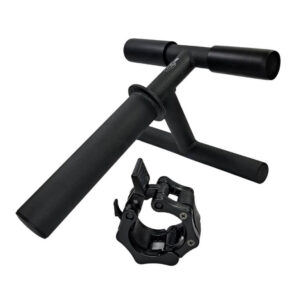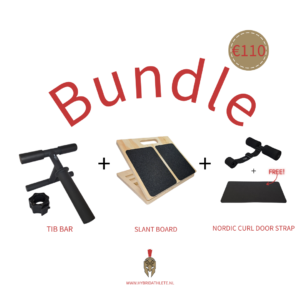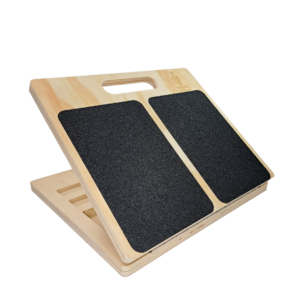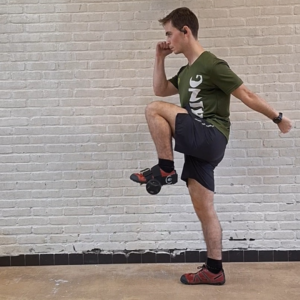
Ankle mobility for runners is becoming a hotter topic by the day. No wonder – as humans, we push ourselves to run faster and longer all the time. One crucial area that often gets overlooked in both aspects is exactly ankle mobility.
The mobility of your ankles can significantly impact your running efficiency and susceptibility to injuries. Let’s explore the significance of ankle mobility for runners, common causes of ankle mobility issues, and most importantly – how to improve ankle mobility to enhance your running experience.
Table of Contents
THE IMPORTANCE OF ANKLE MOBILITY FOR RUNNERS
Ankle mobility essentially means – the range of motion and flexibility of the ankle joint, plain and simple.
It plays a vital role in running mechanics, as it directly affects how your foot interacts with the ground. Insufficient ankle mobility can lead to biomechanical inefficiencies, like overpronation or supination. In turn, this negatively impacts your running performance.
Additionally, limited ankle mobility puts excessive strain on other joints, which increases the risk of injuries.
One effective athletic approach to ankle mobility building is the knees-over-toes methodology, aka KOT.
COMMON CAUSES OF ANKLE MOBILITY ISSUES
TIGHT CALF MUSCLES
Tight calf muscles, specifically the gastrocnemius and soleus muscles, can limit ankle dorsiflexion. When the calf muscles are tight, the ankle has limited ability to flex. This results in a shorter stride length and directly translates to decreased efficiency.
WEAK TIBIALIS ANTERIOR MUSCLE
The tibialis anterior muscle, located at the front of the shin, plays a key role in ankle dorsiflexion. If it’s weak, it leads to limited ankle mobility and reduced control during the push-off phase of running.
PREVIOUS ANKLE INJURIES
Previous ankle injuries, like sprains or fractures, can result in scar tissue formation and joint stiffness. These factors may restrict the range of motion in the ankle joint, leading to decreased mobility.
BENEFITS OF IMPROVING ANKLE MOBILITY
ENHANCED RUNNING PERFORMANCE
Improved ankle mobility allows for a more efficient running gait. With increased stride length and proper ankle dorsiflexion, you generate more power to propel yourself forward. This leads to improved speed and overall running performance.
REDUCED RISK OF ANKLE SPRAINS AND OTHER INJURIES
Distributing the forces of impact evenly throughout the foot and lower leg reduces the risk of overloading specific areas. It also allows for better shock absorption during landings, thus minimizing the strain on joints and muscles.
ANKLE MOBILITY FOR RUNNERS – EXERCISES TO IMPROVE ANKLE MOBILITY
STRETCHING EXERCISES FOR CALF MUSCLES
- Calf Stretch:
Stand facing a wall with one foot in front of the other. Keep your back leg straight and your heel on the ground. Lean forward, pressing your hands against the wall for support, until you feel a stretch in your calf. Hold for 30 seconds on each leg and repeat 2-3 times. - Soleus Stretch:
Assume the same position as the calf stretch but with a slightly bent back knee. Lean forward and feel the stretch in the deeper calf muscle, the soleus. Hold for 30 seconds on each leg and repeat 2-3 times.
STRENGTHENING EXERCISES FOR THE TIBIALIS ANTERIOR MUSCLE
- Toe Raises:
Sit on a chair with your feet flat on the ground. Lift your toes as high as possible while keeping your heels on the ground. Hold for a few seconds, then lower your toes back down. Repeat for 10-15 repetitions and perform 2-3 sets. - Resistance Band Dorsiflexion:
Sit on the floor with your legs straight out in front of you. Loop a resistance band around the ball of your foot and hold the ends in your hands. Flex your foot upward against the resistance of the band, then slowly return to the starting position. Perform 10-15 repetitions on each foot for 2-3 sets. - Tibialis raise with the Tib Bar:
Sit on a bench or box with your feet dangling off the edge. Hook your toes under the Tib Bar so that the bar rests on top of your feet. lift the Tib Bar by flexing your feet upward (dorsiflexion). Hold the top position for a few seconds, then slowly lower the Tib Bar to the starting position. Repeat for 10-15 repetitions and perform 2-3 sets.
USING A SLANT BOARD FOR ANKLE MOBILITY TRAINING
A slant board is a beneficial tool for improving ankle mobility. It allows for a greater stretch and range of motion in the ankle joint. Here’s how to use it:
- Setting up the Slant Board:
Place the slant board on a flat surface, positioning it at a moderate incline. - Stretching on the Slant Board:
Stand on the slant board with your heels at the top and your toes pointing downward. Allow your heels to drop and feel a gentle stretch in your calf muscles. Hold this position for 30 seconds and repeat for 2-3 sets. - Calf Raises on the Slant Board:
Stand on the slant board with your toes at the top and your heels extending over the edge. Rise onto your toes as high as possible, then lower your heels below the board level. Perform 10-15 repetitions for 2-3 sets.
TIPS FOR MAINTAINING ANKLE MOBILITY
In addition to specific exercises, consider implementing these tips to maintain optimal ankle mobility:
- Proper Warm-Up and Cool-Down Routines:
Prioritize dynamic stretches and mobility exercises for your ankles before running, and perform static stretches after your run to maintain flexibility. - Regular Self-Massage and Foam Rolling:
Use a foam roller or massage ball to release tension in your calf muscles and other areas surrounding the ankles. - Choosing Appropriate Footwear:
Select running shoes that provide adequate support and protection to promote natural ankle movement and minimize stress on the joints.
Add Your Heading Text Here
WHAT IS THE IDEAL ANKLE MOBILITY RANGE FOR RUNNERS?
The ideal ankle mobility range for runners is the ability to achieve a 10-20 degree angle of dorsiflexion, allowing for proper foot positioning while running.
CAN ANKLE MOBILITY EXERCISES HELP WITH PLANTAR FASCIITIS?
Yes, ankle mobility exercises can be beneficial in addressing plantar fasciitis. Improving ankle flexibility can reduce strain on the plantar fascia and help with painful symptoms.
HOW OFTEN SHOULD I PERFORM ANKLE MOBILITY EXERCISES?
We recommend you perform ankle mobility exercises at least 2-3 times per week. However, if you have specific ankle mobility issues or are recovering from an injury, consult with a healthcare professional for personalized guidance.
ARE THERE ANY PRECAUTIONS I SHOULD TAKE WHILE USING A SLANT BOARD?
When using a slant board. Always start with a moderate incline and gradually increase the angle over time. You can also try stretching with the help of a pair of squat wedges. Check out our Slant Board vs Squat Wedges guide.
Insist on proper form and listen to your body. If you experience any pain or discomfort, stop the exercise and consult a healthcare professional.
CAN ANKLE MOBILITY EXERCISES IMPROVE MY BALANCE?
Yes, improving ankle mobility can enhance both balance and stability. By increasing ankle flexibility and strengthening the surrounding muscles, you’ll improve proprioception and control during movements, leading to better overall balance.
Wrap Up
As you can see, ankle mobility for runners really does matter. At its core, running is a stressful activity. Microtears and injuries happen all the time. But, every runner knows that the pros outweigh the cons by far. That’s why injury prevention and proper recovery are so important as well.
If you want to run far in the future, think about your ankles today!
Get the best injury prevention training equipment:
GET THE BEST INJURY-PREVENTION TRAINING EQUIPMENT:
Above all, a storyteller. Then comes marketing, branding, writing music, powerlifting, and woodworking.







